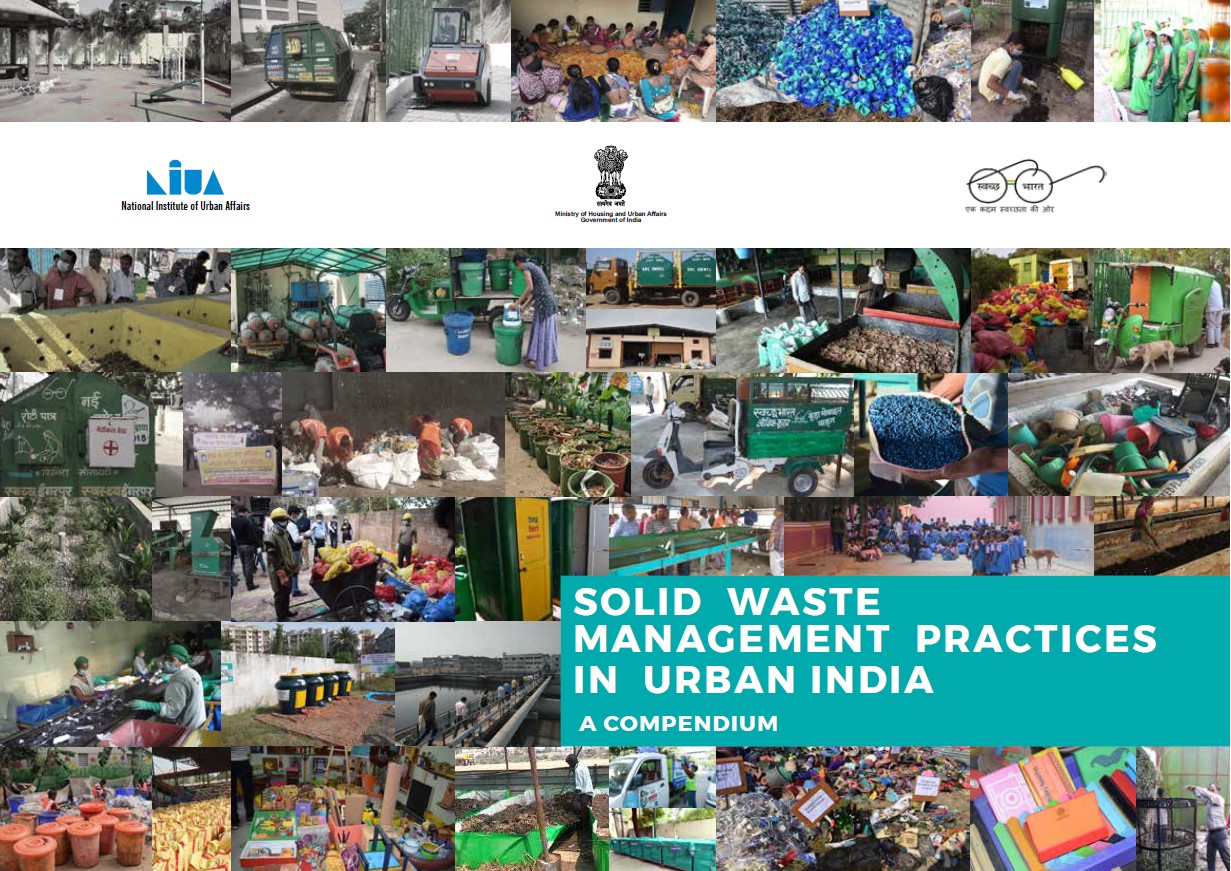Solid and Liquid Resource Management (SLRM) Centre at Amritsar Cantonment Board
Budget : 38.5 Lakh
Innovation Type (Process/ Product): Process
About the Project:
The SLRM Centre is spread over an area of 2.4 hectares in Cantonment board. The implementation of the project is taken up by Swachh Mission co-operative society limited in 2016 with the technical support of India Green Service agency. This centre is efficiently managing the entire collection, transportation system and managing them with suitable techniques, such as composting, manually segregating the RDF fraction and converting the recyclable waste in to value-added products. Centre is preparing value-added products from recyclable products, such as cardboards, clothes, certain plastic materials etc. For instance, cotton towels are converted into beautiful flower pots. These products are displayed during certain occasions and sold to the public to earn funds for the SLRM centre. This SLRM Centre has been developed at a place, where there was slaughter house operating earlier. Army authorities were requested to allot the condemned building to cantonment board for SLRM centre. For this centre the agency have identified and integrated female waste pickers from all over the city and engaged them as key resource after imparting initial training on the SLRM. Currently 3 MT of waste per day is collected from 7 wards covering about 3400 households. It includes about 283 hectares of defence establishment as well. For this purpose, the centre has deployed 7 e-rickshaws and 18 hand carts. Collection of waste is done twice daily. Each e-rickshaw covers about 200 households within an area spanning over a radius of 2.5 km. User fees is being collected by the centre, broadly depending upon the waste generation. Residential households pay Rs. 70 per month, while commercial establishment pay Rs. 140 and Rs. 170 depending upon the generation. While bulk generators (including hotels, restaurants, schools etc.) pay Rs. 2100 per month. Waste comes segregated at the source, which is collected in partitioned vehicles. The dry waste undergoes washing treatment, is segregated further, packed and sold as RDF materials. The organic fraction, which is edible by animals is sent to the dairies or piggeries. After segregation for dairy and piggery usage, the remaining organic fraction is used for making compost. SLRM has achieved great success in segregating the waste in to fractions.
Sector : Solid Waste Management
Pilot City : Amritsar, Punjab
Ownership : Amritsar Municipal Corporation
Know More : mcasr@punjab.gov.in
Connect : mcasr@punjab.gov.in
Solutions
- Garbage Transfer Station (Segregation, Collection and Transportation of Solid Waste in Indore)
- Bin Free City Initiative (Segregation, Collection and Transportation of Solid Waste in Indore)
- Biomethanation Plant for Wholesale Vegetable and Fruit Market (Integrated Solid Waste Processing Facility in Indore)
- Material Recovery Facility (NEPRA: Let’s Recycle)
- Composting of Flower Waste (Brook and Blooms)
- Jatan : Working with young people
- Leaf Litter Processing Unit (LLPU Collection Process in Bengaluru)
- Leaf Litter Processing Unit (Processing at LLPU in Bengaluru)
- Coconut Waste Processing Unit, Freedom Park in Bengaluru
- Vermicomposting plant at Vellalore
- Biogas Plant at Amma Unavagam premises, North Zone
- Gasifier Crematorium at Najundapuram Area
- Micro Composting Centre at Central Market
- Home Composting at Sathya Elite Apartments and housing society in Ellis Nagar
- Waste Management at Meenakshi Temple
- Innovative recycling of waste by Hotel Temple City
- Bio-box technology at GRT Regency Hotel
- The Koyambedu Market Biogas Project
- Green Temple Initiative at Kapaleeswarar Temple, Mylapore
- Project Avthar by Exnora Green Pammal
- Integrated Solid Waste Management Facility at Khat Prakalp - Online monitoring of vehicle and weighing systems
- Integrated Solid Waste Management - Plastic to Fuel Plant
- Decentralised Waste Management at Roseland Society
- Sewage Gas based Power Generation at Bamroli
- Gajuwaka Solid Waste Transfer Unit
- Smart Covered Composting Technology
- Composting at Simhachalam Temple
- Decentralized composting at Tata Reality Infrastructures, Rambagh
- Waste to Energy Plant near I.D.H Hospital
- Scrapshala, Ravindrapuri
- Integration of Technology in Collection and Transportation, Jabalpur, Madhya Pradesh
- Solid and Liquid Resource Management (SLRM) Centre at Amritsar Cantonment Board
- Organic Waste Converter (OWC) at Trillium Mall
- Garden Waste Management
- Bioreactor Landfill, Integrated Solid Waste Management Facility, Municipal Corporation of Greater Mumbai
- Beach Cleaning initiative, Municipal Corporation of Greater Mumbai
- Floral waste to Incense Sticks, Mango Foundation
- Volunteers of the “Mazhi City Taka Tak” Campaign
- Bio-Methanation-cum Electricity Generation Plant
- Zero Waste Management (ZWM) Plant at Kumbarakoppal
- Vermicomposting and Biogas plant at Mysore Zoo
- Zero Waste Campus of Infosys
- Bio-methanation at National Institute of Engineering Campus
- Garden waste and domestic horticulture waste processing at Kanchi Nagar Park
- Dry Waste Collection Centre and Material Recovery Facility (MRF) at Thongum Poonga
- Decentralized Solid Waste Management at Heritage City, Sector 25
- Composting at Nandi Dham Cowshed
- Composting Plant, Jubilee Park
- Dry Waste Collection Centre, Bistupur
- Biogas Plant at Xavier School of Management (XLRI), Sakchi
- Recycling Plastic Waste to Construct Road
- Biomethanation at Kalinga Institute of Social Sciences (KISS) Campus
- Vermicomposting at Nandankanan Zoological Gardens
- Faecal Sludge and Septage Management (FSSM) Plant at Basuaghai
- Waste Warriors - Composting at Gandhi Park
- Decentralized composting at Madhuban Hotel, Rajpur road
- Non-Recyclable Multilayered Plastic Waste Recycling
- Plastic Bottle recycling by “Green Recycling Industry”
Best Practices
Continued Learning
- Global Housing Challenge and the need for an Integrated Housing Strategy at the local level
- Inclusionary Housing in United States: Prevalence and Practices in the Local Jurisdiction
- Informal Housing Supply Continuum in Indian Cities
- Affordable Rental Housing in India
- Introduction eDCR Training on Drawing Standards
- Overview and Process of Double Entry Accounting System
